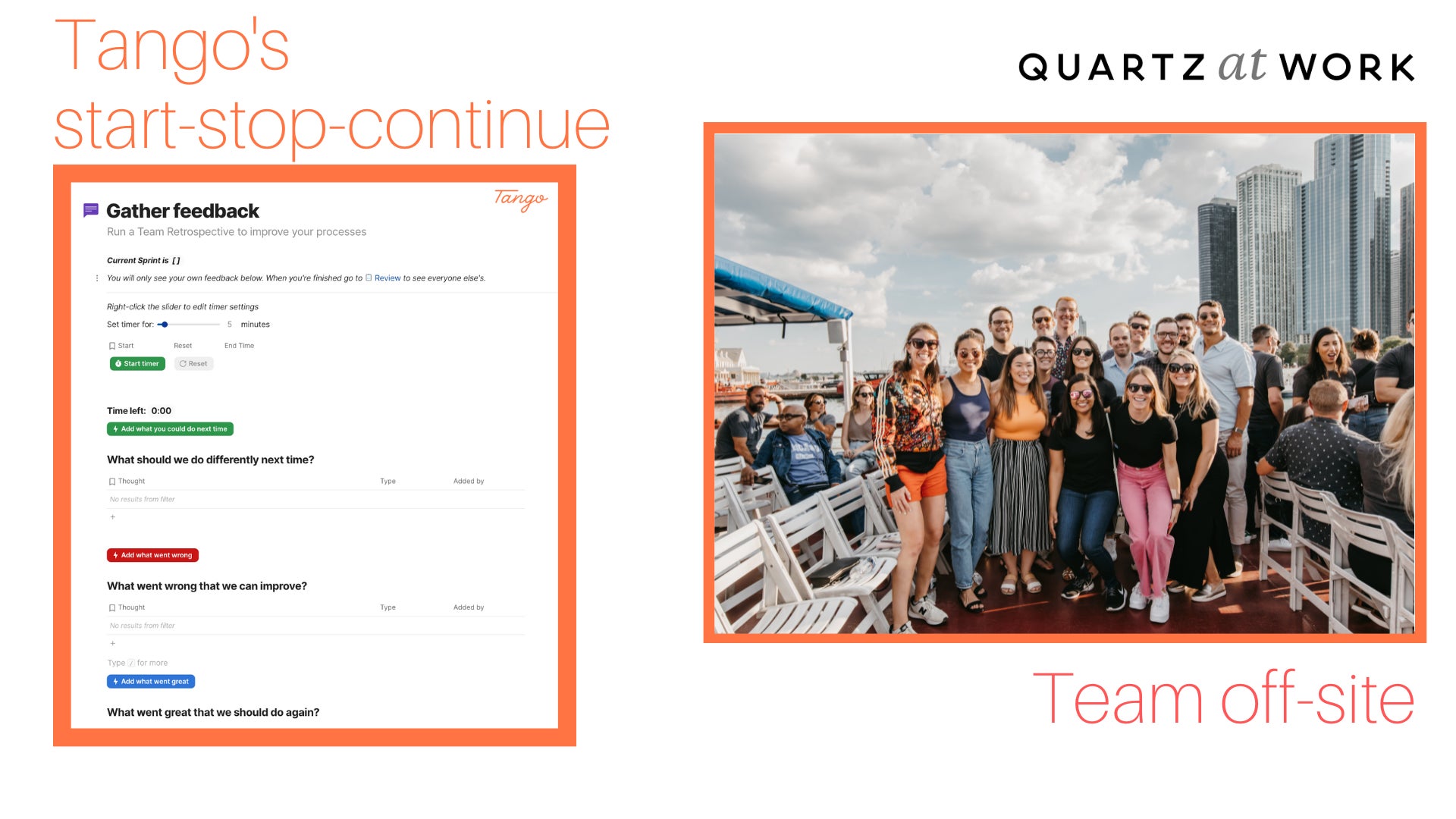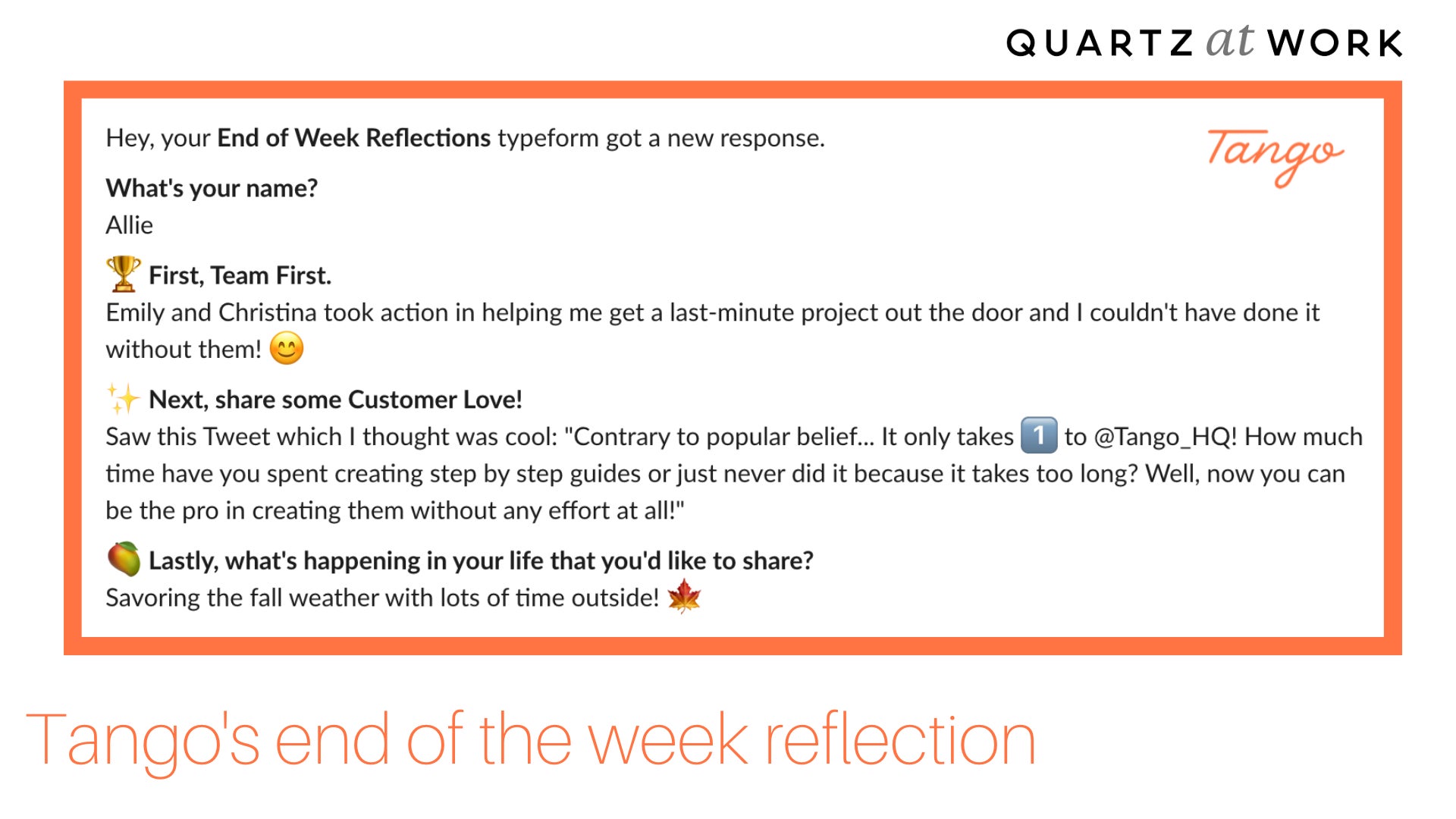How a fully remote team of 30 manages to create vibrant culture
9 tactical tips for remote teams—user manuals, dogfooding, Slack norms, and more

Ken Babcock is the CEO and co-founder of Tango. Before setting out on a mission to help people be their best at work, he spent 4+ years at Uber riding the rollercoaster of a generational company. After getting his feet wet with entrepreneurship at Atomic VC, he went to Harvard Business School, where he met his co-founders.
While remote work is now a staple of the modern workplace, gathering in person at work has its benefits. Time spent together builds trust, and every casual conversation or impromptu brainstorming session shared in the office naturally forges stronger relationships. These are the moments that enable company culture to grow and develop organically. But for remote teams, these opportunities must be thoughtfully planned and organized in order to happen.
As the CEO of Tango, the browser and desktop application that automatically generates how-to guides, I lead a fully remote team of 30 people across 15 states, with two employees overseas. As a result, we’ve had to get creative with how we build relationships and trust across time zones. We’re excited to share what we’ve learned and how we approach operating a fully-remote company in Tango’s remote playbook. Here are nine of our favorite strategies to build connection, communication, and culture.
Build connection quickly
The first few weeks of a new hire’s onboarding experience are critical for providing context, building relationships, and setting expectations. For remote-first companies, it’s even more challenging to build an onboarding process that does all of this (and does it well). But it’s crucial that they do as great onboarding can boost employee retention by 82%.
When we onboard new team members, our priority is that they feel connected—to the people on their team, our product, and the tools and resources they need to do their best work. Here are three practices we’ve implemented to build connection quickly:
Team-wide user manuals. Every new hire completes and shares their personal user manual to help teammates understand how to best work with them. Questions like “How do you like to receive feedback?” and “What’s commonly misunderstood about you?” let people share extra insight about themselves and work more collaboratively.

Dogfooding. We’re big believers in eating our own dog food—or using our own product—so we can keep making it better for our users. Every new hire starts by sharing 10 pieces of feedback on the current product. Not only does this give our team a fresh perspective, but it helps new team members get familiar with our platform by putting themselves in our customer’s shoes right out of the gate.
Shared knowledge. Keeping remote teams connected also means ensuring that internal knowledge is easy to create, share, and discover. For our team, Notion, a project management and note-taking software platform, doubles as our digital office and knowledge library for all things Tango. It’s where we house our internal resources, take meeting notes, track tasks, and brainstorm. If any team member needs an answer, they’ll find it Notion—usually accompanied by a Tango Workflow for extra context!
Communication brings clarity and capacity
Because we can’t stop by each other’s desks or grab a “working lunch” together, remote work requires a higher level of intentionality, consistency, and discipline around communication. Given we’re all remote, we also focus on setting clear boundaries. Here are three ways we use communication to build clarity and capacity.
Slack norms. We rely on norms like:
- “Assume low context” to help others who don’t have as much purview into the topic.
- We encourage our employees to have their messages “default to public” to ensure comprehensive and visible communication for whoever may need it.
- “Thread, don’t spread” encourages employees to discuss in a thread to include the correct people and keep channels organized.
- “Take a breather” encourages breaks and relieves the pressure to respond the fastest or keep your green light on the longest.
Start, stop, continue. This popular retrospective exercise has been crucial for our engineering, product, and design team. Asking questions that facilitate conversation and reflection sets a framework for communication:
- What can we start doing that will improve our process moving forward?
- What should we stop doing that really limited us during this last sprint?
- What should we continue doing because it worked well?
This collective checkpoint ensures that we emerge from a development sprint even stronger for the next one.

No-meeting days. As helpful as frequent and intentional communication can be, it also leads to Zoom fatigue and cuts into focus time. Choosing one day each week when meetings are off-limits gives team members a dedicated day for focused work. For example, we chose Thursdays so team members could catch up on their goals before the week’s end.
Intentional culture building
Company culture can easily get lost in the mix for remote teams, leading to a lack of belonging—or worse, a culture that isn’t aligned with the company’s values. So, companies must be proactive about the culture they want to create. For Tango, we’ve worked hard to build a culture of ongoing support, feedback, and fun.
All hands meetings. This weekly full-team gathering is the best way for everyone to align on company goals, customer feedback, and any issues we need to solve. Given that fun is a key aspect of Tango’s culture, we kick off every all-hands meeting with Zoom breakout rooms and a couple of our team-building icebreaker questions.
End-of-week reflections. Every Friday, the team gets an automated Slack message reminding them to share their reflections on the week. With a TypeForm survey, team members can recognize and celebrate each other, share some customer love, and give a glimpse of something happening in their life that they want to share.

Team-wide offsites. We may be remote-first, but we know there is high value in in-person face time. So we aim to get the full team together three times a year for an offsite, where we focus more on building trust and relationships rather than just in-person co-working.
Accept the work in progress
As our distributed team grows, everything will be a constant work in progress—from our everyday processes to the broader company culture. And though we don’t share an office space, we each share the power and responsibility to shape the Tango experience. Of course, this requires an extra level of intentionality, discipline, and thoughtful planning, but it’s worth it to build a team that’s both fully remote and fully engaged.